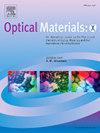Charge trapping in SiO2 substrate during electron beam deposition of CaF2 thin films of different thicknesses
Q2 Engineering
引用次数: 0
Abstract
The charge trapping phenomenon in the SiO2 layer of Si/SiO2 substrates during the electron beam deposition of CaF2 thin films of varying thicknesses (50–277 nm) was studied. Photoelectron emission (PE) spectroscopy was employed to analyze electron trapping mechanisms induced by the deposition process. Distinct peaks corresponding to electron traps in the SiO2 layer were identified in the PE spectra of CaF2 films. The intensity of these peaks varied with the film thickness and the accumulated electron irradiation dose. The study also investigated the relaxation of the PE spectra in both vacuum and air environments. In a vacuum, the PE peaks and integrated PE intensity remained stable for at least 24 h for CaF2 films of all thicknesses. When exposed to air, the PE peaks persisted for several days in films 125 nm thick or thinner but relaxed within several hours in 277 nm films. This rapid relaxation was attributed to a relatively high irradiation dose (about 2.5 mC) obtained during the fabrication of the 277 nm film, leading to an increased concentration of ionized F centers at the SiO2–CaF2 interface and the formation of (O2–-VA) centers upon air exposure. The relaxation of the PE spectrum intensity was attributed to electron transfer from SiO2 traps to (O2–-VA) centers. Furthermore, the possibility of a 260 nm electron escape depth for CaF2 material was confirmed.
电子束沉积不同厚度CaF2薄膜时SiO2衬底中的电荷捕获
研究了电子束沉积不同厚度CaF2薄膜(50 ~ 277 nm)时Si/SiO2衬底SiO2层中的电荷俘获现象。利用光电子发射光谱(PE)分析了沉积过程中引起的电子捕获机制。在CaF2薄膜的PE光谱中发现了与SiO2层中电子阱对应的明显峰。这些峰的强度随薄膜厚度和累积电子辐照剂量的变化而变化。研究了真空和空气环境下PE谱的弛豫。在真空条件下,所有厚度的CaF2薄膜的PE峰和PE综合强度至少在24 h内保持稳定。当暴露于空气中时,在125 nm厚或更薄的薄膜中,PE峰持续数天,而在277 nm薄膜中,PE峰在数小时内松弛。这种快速弛豫归因于277 nm薄膜制备过程中获得的相对较高的辐照剂量(约2.5 mC),导致在SiO2-CaF2界面处电离F中心浓度增加,并在空气暴露时形成(O2—VA)中心。PE谱强度的弛豫是由于电子从SiO2陷阱转移到(O2—VA)中心。此外,还证实了CaF2材料的电子逃逸深度为260 nm的可能性。
本文章由计算机程序翻译,如有差异,请以英文原文为准。
求助全文
约1分钟内获得全文
求助全文
来源期刊

Optical Materials: X
Engineering-Electrical and Electronic Engineering
CiteScore
3.30
自引率
0.00%
发文量
73
审稿时长
91 days
 求助内容:
求助内容: 应助结果提醒方式:
应助结果提醒方式:


